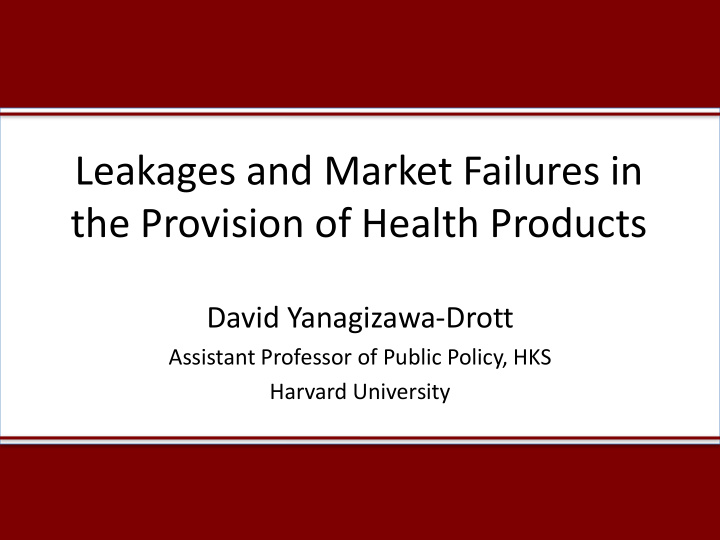



Leakages and Market Failures in the Provision of Health Products David Yanagizawa-Drott Assistant Professor of Public Policy, HKS Harvard University
Motivation • Fake medicines are a global public health problem • Evidence of antimalarial drug quality (Nayyar et al., 2012) • Sampled countries in Southeast Asia: Cambodia, China, India, Laos, Myanmar, Thailand • 35% of medicines in public and private outlets are fake • Prevalence in Sub-Saharan Africa equally high • Similar problem for antibiotics
Common Explanations • Profit motives at all levels in the global supply-chain: manufacturers, counterfeiters, government officials, health care workers, wholesalers, retail drug shops • Insufficient internal quality-control in production process and regulation and monitoring of the supply-chain • Imperfect competition • Widespread self-prescription and poor knowledge about product authenticity among consumers However, there is essentially no evidence of how supply and demand forces drive drug quality, and how to combat the problem - We provide evidence from the private retail sector in Uganda (Bjorkman, Svensson, Yanagizawa-Drott, 2012)
Which one is fake?
Which one is fake? Fake Authentic
Are fake drugs cheaper? • Prices may “ signal ” quality • The problem may be less severe if households can pay a little extra and get authentic drugs • However, the data from Ugandan drugs shops shows that fake drugs are on average sold at the same price as authentic drugs
Do households suspect fake drugs? • Households may partially realize that drugs are fake and ineffective • This would lead to lower demand and treatments among households that believe the drugs are fake • We used household survey data from Uganda to investigate this
Do households suspect fake drugs? 60% 53% 49% 50% 41% 40% 30% 18% 20% 10% 0% Mpigi Mbale Bushenyi Mbarara % Drug Shops Selling Fake Drugs % HH Believes Fake Drugs Are Sold
Is the problem lack of competition? Local Competition in Ugandan villages Local Local Competition Monopoly 49% 51%
Is the problem lack of competition?
Randomized Experiment • NGO Collaboration: BRAC and Living Goods • Intervention: a. Door-to-door Community Health Promoter (CHP) selling authentic antimalarial drugs at a 20-25% subsidized price b. ~100 sample villages, half randomly assigned CHP • Theory of Change: By having an NGO provider that sells authentic drugs at low price: a. Households will get access to authentic medicines, which can increase treatments b. Market forces could drive out the bad drugs from private outlets due to the NGO
Randomized Experiment
Impact: Drug Quality in Drug Shops Program Impact: 20 %-points fewer drug shops sell fake drugs
Impact: Price in Drug Shops Program Impact: 18% lower prices
Impact: Treatment of Sick Children Program Impact: 39% increase in antimalarial medicine use
Conclusion and Way Forward • Evidence of positive market externalities : Fake drugs in private outlets can be driven out by the entry of an NGO committed to high quality and low price • Interventions directly targeting the retail sector can be highly effective • Potential interventions and policies: • Monitoring of quality in public and private outlets • Technological solutions • Certification and consumer information schemes
Recommend
More recommend